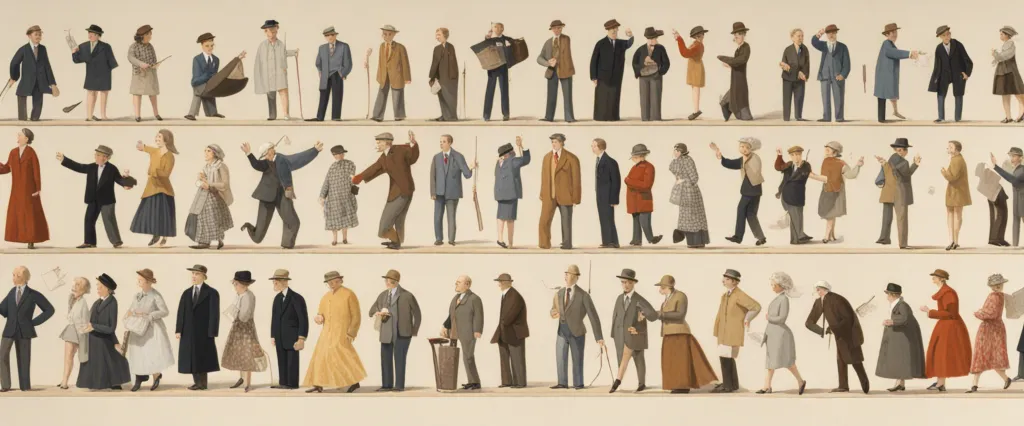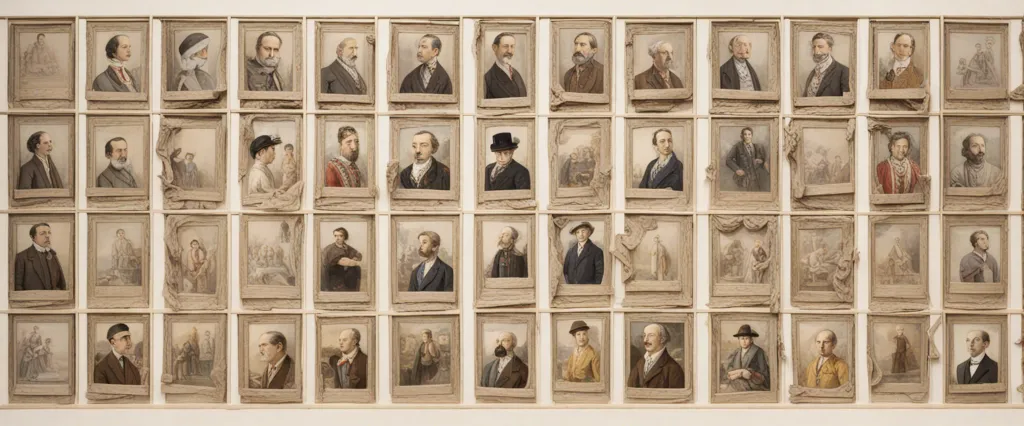In “Decisive Moments in History Twelve Historical Miniatures,” Stefan Zweig delves into the intricacies of significant events that shaped our world. With his profound storytelling abilities, Zweig offers a riveting glimpse into these crucial turning points, unraveling their underlying duality of chaos and order. An immensely talented Austrian writer and biographer, Stefan Zweig (1881-1942) is renowned for his captivating narratives that blend historical accuracy with deep psychological insights. Having penned numerous works on notable figures such as Marie Antoinette, Fyodor Dostoevsky, and Sigmund Freud, Zweig’s meticulous research and vivid prose continue to captivate readers, making him one of the most celebrated biographers of the 20th century.
Chapter 1: The Field of Waterloo
Chapter 1: The Field of Waterloo, from Stefan Zweig’s book “Decisive Moments in History: Twelve Historical Miniatures,” explores the monumental battle that took place on June 18, 1815, which ended Napoleon Bonaparte’s dominance in Europe.
Zweig begins by painting a vivid picture of the political landscape in Europe during the early 19th century. Following the French Revolution, Napoleon’s rise to power had brought both glory and turmoil to the continent. However, by 1815, the once formidable emperor found himself facing a formidable alliance of nations determined to put an end to his reign.
The author skillfully describes the buildup to the battle, detailing the tactical strategies employed by both Napoleon and the Duke of Wellington, the British commander-in-chief. Zweig highlights the contrasting personalities of these two iconic figures, with Napoleon’s audacity and unyielding pursuit of victory contrasted against Wellington’s cautious and strategic approach.
As the battle unfolds, Zweig’s narrative captures the sheer brutality and chaos of war. He describes the carnage, the deafening sounds of cannons, and the relentless cavalry charges that characterized the Battle of Waterloo. The author emphasizes the pivotal role that individual commanders, such as Marshal Ney and Lieutenant Colonel Hougoumont, played in determining the outcome of the conflict.
Ultimately, the battle ends in Napoleon’s defeat, marking the end of his imperial ambitions. Zweig reveals the profound impact this single battle had on European history, showing how it reshaped the political landscape and ensured a long-lasting peace on the continent.
In Chapter 1, Zweig masterfully conveys the drama and significance of the Battle of Waterloo, introducing readers to the larger themes of power, leadership, and the delicate balance between triumph and defeat that are explored throughout the rest of the book.
Chapter 2: The Journey into the Past
Chapter 2: The Journey into the Past of the book “Decisive Moments in History: Twelve Historical Miniatures” by Stefan Zweig explores the psychological phenomenon known as nostalgia and its historical significance. The chapter delves into the concept of nostalgia as a yearning for a bygone era, a longing for the past that is deeply embedded in human nature.
Zweig begins by discussing how nostalgia was originally considered a debilitating condition affecting soldiers in war, as they yearned for the familiar and comfortable surroundings of home. However, he goes on to argue that nostalgia is not merely a personal sentiment but has implications on a larger scale.
The chapter then transitions to the historical period of the French Revolution, where a wave of nostalgia swept across Europe for the perceived virtues of the past. Zweig focuses on the contrasting experiences of Louis XVI and Marie Antoinette – the former longing for a return to absolute monarchy, and the latter embracing the changing times. This divergence ultimately led to their downfall, as they were unable to adapt and understand the desires of the people.
Zweig also discusses how nostalgia influenced the perception of Napoleon Bonaparte. He posits that the longing for stability and certainty in a rapidly changing world led people to idealize Napoleon as a symbol of power and security. However, Napoleon’s eventual demise reveals the dangers of nostalgia, as it blinds individuals and society to the flaws and limitations of a romanticized past.
The chapter concludes by emphasizing the importance of learning from history without succumbing to nostalgia. Zweig states that the true lesson to be learned is to embrace progress while remaining grounded in the realities of the present.
In summary, “Chapter 2: The Journey into the Past” of “Decisive Moments in History” explores the concept of nostalgia, its impact on individuals and societies, and its role in shaping historical events. Zweig urges readers to acknowledge nostalgia as a powerful force, but also warns against becoming trapped in an idealized past, as it can hinder progress and lead to undesirable outcomes.
Chapter 3: The Genius of a Night
Chapter 3: The Genius of a Night, from the book “Decisive Moments in History: Twelve Historical Miniatures” by Stefan Zweig, delves into the events of August 24, 1572, known as the St. Bartholomew’s Day Massacre in France. In this chapter, Zweig explores how one night of intense violence reshaped the course of history.
The chapter begins by providing historical context, explaining the turbulent religious climate in France, with tensions mounting between Protestants (Huguenots) and Catholics. The weak King Charles IX, under the influence of his dominating mother, Catherine de’ Medici, enters into alliances with Huguenots, leading to a temporary peace. However, Charles, grasping the opportunity to please the Catholic factions, suddenly shifts in support, leading up to the infamous massacre.
Zweig emphasizes how this night, planned with military precision, shattered any sense of trust and safety among the Huguenots. In chilling detail, he describes the systematic violence unleashed upon them, their hopelessness, and desperate attempts to escape the bloodshed.
The significance of this event lies in the profound impact it had on European history. The massacre triggered a wave of violence and counter-violence across French cities, further dividing the nation along religious lines. The repercussions were felt not just in France but also throughout Europe, affecting the balance of power between Catholicism and Protestantism for centuries to come.
Zweig concludes the chapter by reflecting on how one single night could transform the fate of nations and the lives of countless individuals. St. Bartholomew’s Day Massacre, he suggests, exemplifies the unpredictable nature of history, where a sudden, sinister genius can change the world.
Chapter 4: The Battle with the Demon

Chapter 4: The Battle with the Demon
In Chapter 4 of the book “Decisive Moments in History: Twelve Historical Miniatures” by Stefan Zweig, the author explores the dramatic events surrounding the Battle with the Demon. This chapter delves into a historical event where humanity, in a state of fragility, managed to triumph against great odds.
Zweig sets the scene in Amsterdam during the 17th century, a time when the Dutch were in a prosperous and influential position worldwide. However, this success came at a cost, as the Dutch society had become arrogant and disenchanted. The author likens this arrogance to a demon slowly draining the life and spirit of the people.
The narrative then shifts to the story of a Dutchman named Dietrich Grönke. Grönke is depicted as a man struggling to defeat his inner demons and find purpose in life. After experiencing a personal tragedy, he seeks redemption and takes up the cause against the metaphorical demon tormenting his countrymen.
This battle with the demon manifests through an internal conflict within Grönke, who portrays the internal struggles faced by the Dutch society. With vivid and eloquent prose, Zweig recounts Grönke’s transformation from a broken and desolate man into a symbol of hope and resilience.
Grönke becomes a champion for the Dutch people, inspiring them to reclaim their spirit and confront their arrogance. Zweig portrays the Battle with the Demon not as a physical conflict, but as a psychological and spiritual struggle for self-discovery and societal rejuvenation.
In the end, Grönke’s determination and bravery uplifts the worn-out and disenchanted Dutch society, leading to a triumph over their inner demon. Zweig concludes the chapter by emphasizing the importance of individual resilience and self-reflection in overcoming societal challenges.
Chapter 4: The Battle with the Demon serves as a reminder of the power of humility and introspection, depicting a pivotal moment in history where one man’s journey mirrors the plight of an entire nation.
Chapter 5: The World in a Nutshell
Chapter 5: The World in a Nutshell, from the book “Decisive Moments in History: Twelve Historical Miniatures” by Stefan Zweig, explores the discovery and significance of the Treaty of Tordesillas. This treaty, signed in 1494, had a profound impact on the shaping of the modern world.
Zweig begins by describing the context of the mid-fifteenth century, when Portuguese explorers embarked on voyages to find new trade routes to the East. They successfully reached India, but their achievement alarmed the Spanish Crown, who held immense power at the time. To avoid potential conflict and establish boundaries, the Pope was called upon to mediate the situation.
Pope Alexander VI played a central role in this chapter, acting as the mediator between Portugal and Spain. He proposed a line of demarcation, dividing the entire non-European world into two hemispheres. The treaty stated that all unexplored lands to the west of this line would belong to Spain, while those to the east were granted to Portugal.
Zweig emphasizes the unprecedented nature of this agreement. For the first time, two powers turned their attention beyond Europe and laid claim to vast territories across the globe. The treaty laid the foundation for the conquests of the Americas and the colonization of Africa and Asia.
The author captures the overwhelming scope of the treaty’s impact. He highlights how it influenced the colonization of Brazil and the conflicts between European powers across the globe. Furthermore, it significantly influenced how the world map was drawn, as well as the cultural, linguistic, and political dynamics still present today.
In this chapter, Zweig masterfully explores how this one treaty, negotiated and signed in a small Spanish town, changed the course of history. The Treaty of Tordesillas opened the door to a new era of exploration, colonization, and global power struggles that continues to shape the world we live in.
Chapter 6: The Miracle of the Huts
Chapter 6: The Miracle of the Huts from the book “Decisive Moments in History: Twelve Historical Miniatures” by Stefan Zweig describes a pivotal event during the reign of Peter the Great, which solidified Russia’s position as a world power by transforming its military capabilities.
At the beginning of the chapter, Zweig sets the stage by highlighting Russia’s disadvantages: a vast territory, backwardness compared to Western European powers, and a lack of a well-organized army. Peter the Great, then the Tsar of Russia, recognized these shortcomings and embarked on a grand plan to modernize the nation, starting with the military.
Peter reallocated substantial resources and brought in foreign experts to train his soldiers. However, his transformational project faced a critical test in 1709 during the Battle of Poltava. Coming face-to-face with the Swedish forces, who were considered one of Europe’s best armies at the time, Peter found his troops outnumbered and outgunned.
In the face of adversity, Peter adopted an unconventional strategy: he ordered his troops to construct makeshift huts with available materials. These huts acted as impromptu fortifications that protected the soldiers from enemy fire and provided them with a psychological advantage. The Swedish army, not anticipating such a defensive tactic, was puzzled by the seemingly defensive Russian stance.
When the battle commenced, the Swedish forces found themselves unable to break through the Russian defenses, suffering heavy losses. The huts, combined with the superior discipline and tactics of the Russian army, turned the tide of the battle, resulting in a resounding victory for Russia. This unexpected triumph marked a turning point in Peter’s reign and firmly established Russia as a military power, ultimately leading to the country’s ascension as a major player on the world stage.
In Chapter 6: The Miracle of the Huts, Stefan Zweig eloquently portrays how Peter the Great’s ingenuity and strategic thinking, coupled with the innovative use of huts as defensive positions, shaped Russia’s destiny and solidified its presence among the great powers of Europe.
Chapter 7: The First Word to Cross the Ocean
Chapter 7: The First Word to Cross the Ocean, from the book Decisive Moments in History Twelve Historical Miniatures by Stefan Zweig, explores the development of communication through the transatlantic telegraph cable in the mid-19th century.
Zweig begins by explaining the significance of communication in human history and how advancements in technology have revolutionized it. He highlights the importance of transatlantic communication at a time when the continents were still largely disconnected, with messages taking several weeks to travel by ship.
The chapter then delves into the story of Cyrus West Field, an American entrepreneur who embarked on a mission to lay a telegraph cable across the Atlantic Ocean. Field was driven by the belief that connecting Europe and America through instantaneous communication would have a profound impact on diplomacy, trade, and culture.
Zweig vividly describes the numerous failed attempts to lay the cable due to technical, financial, and logistical challenges. Field faced immense skepticism and financial setbacks, but his determination and visionary mindset pushed him to persist. He eventually formed a successful partnership with British engineers and secured the necessary funding to make his dream a reality.
The narrative then shifts to the critical moment when, in 1866, the cable was finally laid and communication between Europe and America became possible within minutes. Zweig emphasizes the transformative power of this achievement, recognizing it as a true turning point in history.
In conclusion, Chapter 7 highlights the tenacity, vision, and ambition of Cyrus West Field, who played a pivotal role in connecting the continents through the transatlantic telegraph cable, forever changing the way nations communicated and impacting the course of history.

Chapter 8: The Resurrection of George Frideric Handel
Chapter 8 of “Decisive Moments in History: Twelve Historical Miniatures” by Stefan Zweig is titled “The Resurrection of George Frideric Handel.” This chapter focuses on the incredible revival of the composer’s fame and reputation during the final years of his life.
Zweig begins by explaining how Handel, despite being a prolific and highly regarded composer during the 18th century, faced a decline in popularity and financial struggles towards the end of his career. Following the premiere of his oratorio “Jephtha,” Handel’s health deteriorated, and he was left physically and emotionally exhausted. His last years were marked by financial difficulties, failures in his operas, and a sense of despair and disillusionment.
However, in the spring of 1750, the tide began to turn for Handel. A young German music enthusiast named Johann Adam Hiller discovered Handel’s music and recognized its exceptional brilliance. Hiller was determined to revive Handel’s works and reintroduce them to the public. With the support of influential figures, including the King of Prussia, Hiller organized a series of concerts solely dedicated to Handel’s music.
The revival of Handel’s compositions turned out to be an immense success. The audiences, composed of both aristocrats and common people, were deeply moved by the grandeur and emotional depth of Handel’s music. Handel’s oratorios, such as “Messiah,” became particularly popular, and he experienced a renewed flourishing of his reputation.
Zweig portrays this chapter as a resurrecting triumph for Handel, whose music managed to captivate and inspire a new generation. Despite the financial hardships and personal struggles he faced in his final years, Handel’s compositions triumphed and secured his legacy as one of the greatest composers of all time. The revival of Handel’s music demonstrated the power of human perseverance and the ability for timeless art to captivate and inspire across generations.
After Reading
In “Decisive Moments in History: Twelve Historical Miniatures” by Stefan Zweig, the author presents a collection of captivating stories that highlight pivotal moments in history. Throughout the book, Zweig demonstrates his masterful storytelling skills while shedding light on lesser-known, yet significant events that have shaped the course of humanity. From intricate political schemes to life-altering encounters, Zweig emphasizes how seemingly trivial occurrences can have far-reaching and transformative consequences. His keen observation of human behavior and meticulous research make this collection a compelling read for history enthusiasts. Through these twelve historical miniatures, Zweig reminds us of the power and unpredictability of decisive moments, and the lasting impact they can have on the world.
1. “The Six Wives of Henry VIII” by Alison Weir – This historical book provides insightful narratives of the six wives of Henry VIII, offering a fascinating glimpse into the tumultuous Tudor period and the decisive moments that shaped the fate of each queen.
2. The Guns of August” by Barbara W. Tuchman – Focusing on the outbreak of World War I, this influential book delves into the crucial moments and decisions made by leaders and nations that led to the cataclysmic conflict. Tuchman’s thorough research and engaging storytelling make it a must-read.
3. 1776″ by David McCullough – McCullough recreates the pivotal year of the American Revolution, emphasizing the significant moments that determined the fate of the fledgling nation. Through detailed accounts and personal stories of key figures, this book presents history in a compelling and accessible way.
4. Genghis Khan and the Making of the Modern World” by Jack Weatherford – Weatherford’s book explores the life and conquests of Genghis Khan, providing a deeper understanding of the Mongol Empire and its impact on global history. This captivating narrative reveals the decisive moments that transformed Genghis Khan into a legendary figure.
5. The Wright Brothers” by David McCullough – Highlighting the momentous milestones in early aviation, McCullough’s book chronicles the story of the Wright brothers and their groundbreaking achievements. Through meticulous research and vivid storytelling, the author captures the decisive moments that revolutionized human flight.




